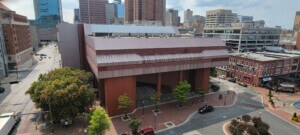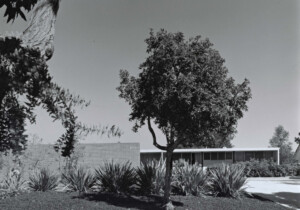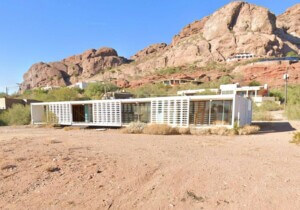The Frank Lloyd Wright Building Conservancy is sounding the alarm over what the nonprofit perceives to be a threat to the Frederick Bagley House, a “unique and irreplaceable” early work by Frank Lloyd Wright in the western Chicago suburb of Hinsdale.
An 1894 Dutch Colonial revival affair complete with a columned veranda that runs the length of the house and a gambrel roof characteristic of the late-19th-century architectural style, the five-bedroom residence at 121 South County Line Road in Hinsdale recently appeared in a (now unavailable) listing marketed to a “limited audience” by @properities. As detailed by the Conservancy, the $1.3 million listing reportedly touted the village of Hinsdale and the property itself but made no mention of Wright or the historic significance of the home. This has led the Conservancy to believe that the Frederick Bagley House, which enjoys no legal protection, could potentially befall the same fate as the older homes located on the lots immediately south and north, which have since been demolished to make for larger, modern replacements. As noted by the Conservancy, this is an all-too-common practice in Hinsdale. Last July, a six-month village-wide moratorium on the demolition of historic homes was opposed by the Hinsdale Plan Commission. The following month, the moratorium was rejected by village trustees.
“The Bagley House is a vital part of Wright’s canon and its loss would be tragic for the Wright community, historians and architecture lovers everywhere,” wrote the Conservancy in a news release.

Commissioned by marble exporter Frederick Bagley, the home is a markedly revivalist design that stands apart from the more characteristic Prairie- and Usonian-style Wright residences found throughout Chicagoland. Still, it features elements that Wright, who would have been 27 or so at the time of the home’s completion, incorporated into later projects. Chief among them is an octagonal library that extends from the home; Wright’s own Oak Park Studio library, completed in 1898, took a similar form.
In an email to AN, Barbara Gordon, executive director of the Frank Lloyd Wright Building Conservancy, further detailed that the Bagley House is one of only two Wright-executed works with fully-rendered classical details, the other being the still-standing Blossom House (1893) in Chicago. It is also the only Wright-designed home in Hinsdale.
Referring to the Bagley House as an “an important product of the early years of his independent practice after he left the firm of Adler & Sullivan,” the Conservancy added: “In these years he explored numerous forms and design motifs that would surface in his UNESCO World Heritage-listed works Unity Temple and Robie House a little over a decade later.”
Other Wright works completed in 1894 include the Robert R. Roloson Houses, a quartet of Chicago rowhouses added to the National Register of Historic Places in 1977, and the Winslow House in River Forest, another western Chicago suburb. This pivotal project marked Wright’s first commission as an independent architect and was his inaugural Prairie-style design. It was added to the National Register of Historic Places in 1970.
The Bagley House in Hinsdale, it should be noted, isn’t the only Wright-designed home bearing that name. Twenty years after he designed the now-under-threat Dutch Colonial for Frederick Bagley in Hinsdale, Wright designed the Joseph J. Bagley House, one of three lakefront cottages completed in 1916 in Grand Beach, Michigan. One of them, the William S. Carr House, was razed in 2004, marking the first time that a Wright home had been demolished in three decades.
Back in Hinsdale, the Conservancy is hoping that a preservation-minded buyer who will take steps to legally protect the home and potentially pursue local landmark designation emerges. It is also urging those who are upset by the uncertain future of the Bagley House to take action by emailing Village of Hinsdale officials and voicing their concerns. The contact info for the appropriate officials can be found here.
“The Bagley House’s design is in keeping with the traditional building styles that we see in these new homes, and restoring and adding a sensitive addition to expand the home would make this a very unique and marketable property for the right preservation-minded buyers,” said Gordon.











